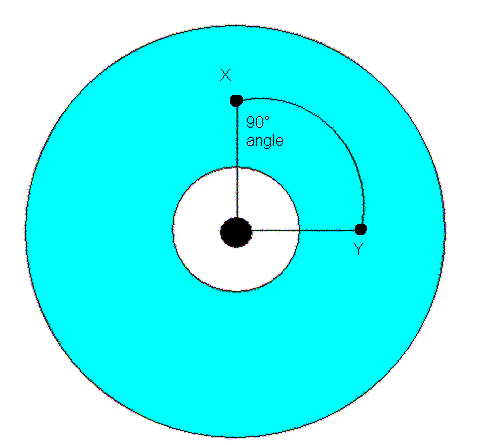The
idea behind these protections is relatively easy to understand, despite what
you may read. First, remember angles? Good.
Now, you can imagine each sector on the disc not only as on a line, but also as an angle in relation to another sector. For example, in the diagram below, sectors X and Y are at a 90° angle to each other.

You might see where this is going. You see, a burnt CD has (should have) a smooth density of sectors, but the protected CD's have irregular densities. So, the Sectors X and Y will be physically on different places on the CD. The guard module detects this, and refuses to run. But this leads us to another question: How does it detect this?
The answer is simple: Seek times. Since the sectors are different distances apart, they will have different seek times on the copy than on the original. To figure out how far apart the sectors are, you actually need three check points, but that is not important to understanding the protection (More on this at a later date, but you can figure it out by yourself, I hope).
Defeating it: The big question right now. The first way, suggested here, uses Twin Sectors, but filled with the same data, so that they are undetectable. This increases the times to seek between sectors, fooling the guard module. But this method is not precise enough, Securom is already being improved to defeat it. A more accurate, though incredibly more complex, method, would be to use buffer under-run prevention technology. This technology lets the disc coast in the drive for a while, which increases read times when reading the disc. However, it is doubtful that this method will be implemented anytime soon, due to immense coding complexity.
So, has the community been defeated? In a way. This protection has defeated us, at least for the time being. But angle based protections will most likely kill themselves, making the need to copy them irrelevent. This type of protection is very expesive to implement, and is hard to implement in large numbers. All we can do is hope.
Now, you can imagine each sector on the disc not only as on a line, but also as an angle in relation to another sector. For example, in the diagram below, sectors X and Y are at a 90° angle to each other.
You might see where this is going. You see, a burnt CD has (should have) a smooth density of sectors, but the protected CD's have irregular densities. So, the Sectors X and Y will be physically on different places on the CD. The guard module detects this, and refuses to run. But this leads us to another question: How does it detect this?
The answer is simple: Seek times. Since the sectors are different distances apart, they will have different seek times on the copy than on the original. To figure out how far apart the sectors are, you actually need three check points, but that is not important to understanding the protection (More on this at a later date, but you can figure it out by yourself, I hope).
Defeating it: The big question right now. The first way, suggested here, uses Twin Sectors, but filled with the same data, so that they are undetectable. This increases the times to seek between sectors, fooling the guard module. But this method is not precise enough, Securom is already being improved to defeat it. A more accurate, though incredibly more complex, method, would be to use buffer under-run prevention technology. This technology lets the disc coast in the drive for a while, which increases read times when reading the disc. However, it is doubtful that this method will be implemented anytime soon, due to immense coding complexity.
So, has the community been defeated? In a way. This protection has defeated us, at least for the time being. But angle based protections will most likely kill themselves, making the need to copy them irrelevent. This type of protection is very expesive to implement, and is hard to implement in large numbers. All we can do is hope.